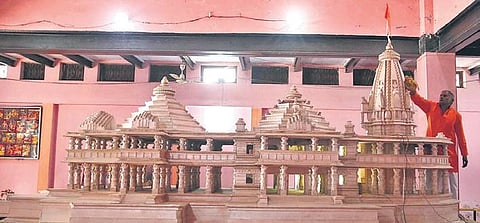

A foreign broadcaster wanted to know what I felt, as the former head of Prasar Bharati, about Doordarshan preparing to telecast live the proceedings of the groundbreaking ceremony for a Ram mandir at Ayodhya. I replied evasively as I was schooled in service, but this issue of a supposedly neutral and secular public broadcaster covering an event glorifying one religion is quite touchy.
Doordarshan could have been chosen as it has proven multi-camera skills — it coordinates ‘simultaneous feed’ from 50 cameras on Republic Day parade in New Delhi. While the local stations of Akashvani and Doordarshan do ‘live coverage’ of many important religious festivals, some of which are of other religions at the national level, DD has been very selective, because of its mandate. Even so, it does cover Jagannath’s Rath yatra at Puri and several Kumbh melas as ‘live programmes’ — more as great human congregations — not as the ‘triumph’ of one religion.
Yet, we hardly notice that it is the same Doordarshan that flagged off this battle for Ayodhya — inadvertently or otherwise. Most of us do not recall that Congress had won a landslide victory after Indira Gandhi’s assassination on 31st October 1984. There is no doubt the Doordarshan, the state-owned monopoly, played a big role by relaying heart-wrenching scenes of Mrs Gandhi’s last journey. But by the end of 1986, Rajiv Gandhi was being mauled over the Bofors guns purchase deal.
This is when his information and broadcasting minister Ajit Panja decided to telecast religion over television — even though the government was avowedly secular. DD began telecasting Ramayan from 25th January 1987 and the serial became unimaginably popular. Hinduism was actually ‘defrosted’ from cold preachings that were anyway far less rigorous or mandatory than most other religions. But this was the first time that even the unlettered came to know every detail of the two televised epics that occupied centre-stage in India till Gods, sages and warriors came on miraculously alive before enthralled audiences as Ramanand Sagar and BR Chopra weaved sheer magic on DD’s screen. This was, in fact, a quantum jump since medieval regional poets had re-created their local versions in a manner that the masses could relate to, almost a millennium after Valmiki’s Sanskrit original.
By 31st July 1988 when Ramayan’s 78 episodes were over, the golden harvest of nuevo religious fervour was swaying in the wind, ever so temptingly. The Congress, that had tampered with the delicate secular balance, could hardly visualise what force it had unleashed and started televising the Mahabharat from 2nd October 1988. It was the Bharatiya Janata Party (BJP) under LK Advani that went in to reap the crop and selected a nondescript muffasil town, Ayodhya, as the epicentre. It was in the heart of Gangetic Hindi-Hindu belt and the fact that the Muslim invader Babur’s name was embedded on a mosque built over the “very spot where Ram was born” was, indeed, a godsend.
In January 1989, Advani heated the political atmosphere by declaring that his supporters would hold the holy stone-laying ceremony at that spot just ten months later. Lakhs of Hindu pilgrims assembled at the Prayag Kumbh mela roared in support, while the Babri Masjid Action Commitee aroused Muslim opposition to this. The Congress, however, congratulated itself for telecasting the most successful epic serial on the secular state’s own network. In November 1989, Advani performed his shilanyas of Ram Mandir at Ayodhya in the midst of riotous excitement, and instantly, the BJP’s tally of Lok Sabha seats went up to 85 from the earlier 2 that it had secured in the first elections it faced in1984.
Foreign scholars like Christophe Jaffrelot, David Ludden, Philip Lutgendorf and James Hegarty have written about the tremendous impact that these TV shows had on the hitherto-uninvolved Hindu citizenry, but somehow this nexus has not excited mainstream Indian academics.
By 1990, Rajiv Gandhi was out but Doordarshan went on delivering ‘religious shots’ week after week with Mahabharat that telecast 94 episodes. We will not dwell on Advani’s Ratha-Yatra that followed, igniting riots all over except to mention that the BJP won even more seats (120) in 1991. Left and secular forces went on a highly academic overdrive questioning Ram’s very existence, which did not endear them to the recharged Hindu masses and historians produced evidence to prove that there was no mandir under or around Babri Masjid.
But who was listening? We will not recall the blood that was let out after the destruction of the Babri Masjid on 6th December 1992. In any case, the highest court has painstakingly dissected its own evidence and handed over the disputed plot in Ayodhya to the Hindus. The same urgency and enthusiasm was hardly evident in punishing those that the court itself had sternly reprimanded for destroying Babri Masjid. It is now all done and dusted.
Doordarshan moved on to eulogising whichever government came to power and the paymaster decided what better subjects to cover. And if an unforgiving regime has decided that the ‘groundbreaking ceremony’ for the proposed grand temple to Ram has to be covered for one community, at government expense, well — it has to be covered. After all, Narendra Modi had sailed to power in 2014 on the crest of a tsunami that was let loose just as a wave in Ayodhya, exactly 25 years ago.
Jawhar Sircar
Writer is former CEO of Prasar Bharati